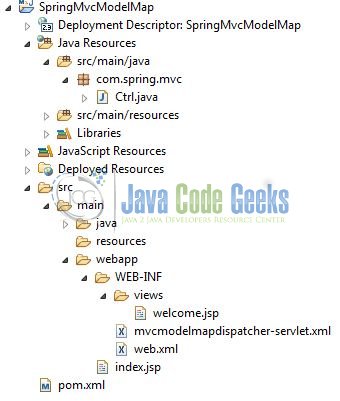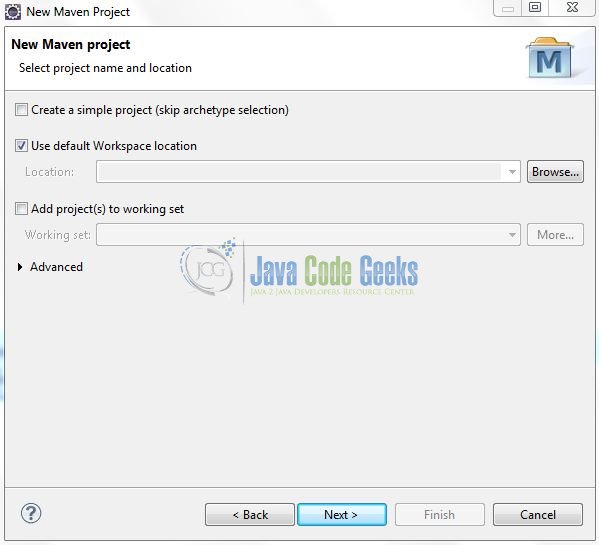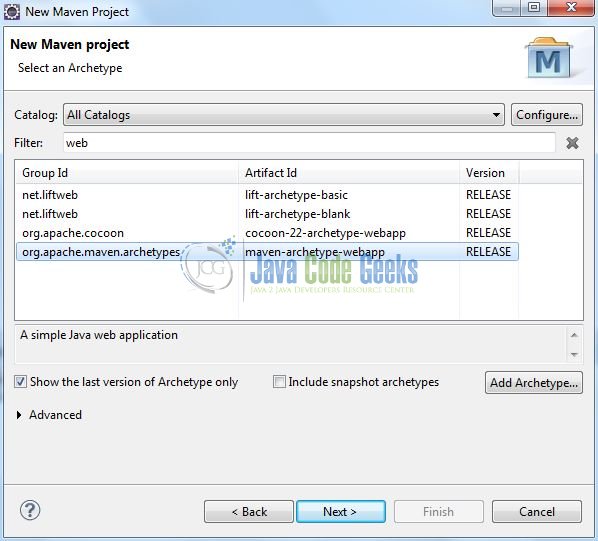Spring MVC ModelMap Example
In spring mvc, the org.springframework.ui.ModelMap object is used to pass the multiple values from the spring controller to the view. In this tutorial, we will show how to implement the org.springframework.ui.ModelMap object with the spring mvc framework.
1. Introduction
1.1 Spring Framework
- Spring is an open-source framework created to address the complexity of an enterprise application development
- One of the chief advantages of the Spring framework is its layered architecture, which allows a developer to be selective about which of its components they can use while providing a cohesive framework for
J2EEapplication development - Spring framework provides support and integration to various technologies for e.g.:
- Support for Transaction Management
- Support for interaction with the different databases
- Integration with the Object Relationship frameworks for e.g. Hibernate, iBatis etc
- Support for Dependency Injection which means all the required dependencies will be resolved with the help of containers
- Support for
RESTstyle web-services
1.2 Spring Mvc Framework
Model-View-Controller (Mvc) is a well-known design pattern for designing the GUI based applications. It mainly decouples the business logic from UI by separating the roles of Model, View, and Controller in an application. This pattern divides the application into three components to separate the internal representation of the information from the way it is being presented to the user. The three components are:
- Model (M): Model’s responsibility is to manage the application’s data, business logic, and the business rules. It is a
POJOclass which encapsulates the application data given by the controller - View (V): A view is an output representation of the information, such as displaying information or reports to the user either as a text-form or as charts. Views are usually the
JSPtemplates written with Java Standard Tag Library (JSTL) - Controller (C): Controller’s responsibility is to invoke the Models to perform the business logic and then update the view based on the model’s output. In the spring framework, the controller part is played by the Dispatcher Servlet

1.3 Spring Mvc ModelMap Class
The ModelMap class subclasses the LinkedHashMap and provides some additional benefits i.e.
- It provides the
addAttribute()method to put the key-value pair. This method returns theModelMapobjects that can be used for chaining ModelMapchecks for thenullvalues and uses theMap<String, Object>generic type
Now, open up the Eclipse IDE and let’s see how to use the org.springframework.ui.ModelMap class in the spring framework!
2. Spring MVC ModelMap Example
Here is a step-by-step guide for implementing this annotation in the spring mvc framework.
2.1 Tools Used
We are using Eclipse Kepler SR2, JDK 8 and Maven. Having said that, we have tested the code against JDK 1.7 and it works well.
2.2 Project Structure
Firstly, let’s review the final project structure, in case you are confused about where you should create the corresponding files or folder later!

2.3 Project Creation
This section will demonstrate how to create a Java-based Maven project with Eclipse. In Eclipse IDE, go to File -> New -> Maven Project.

In the New Maven Project window, it will ask you to select the project location. By default, ‘Use default workspace location’ will be selected. Just click on the next button to proceed.
Select the Maven Web App archetype from the list of options and click next.
It will ask you to ‘Enter the group and the artifact id for the project’. We will input the details as shown in the below image. The version number will be by default: 0.0.1-SNAPSHOT.
Click on Finish and the creation of a maven project is completed. If you observe, it has downloaded the maven dependencies and a pom.xml file will be created. It will have the following code:
pom.xml
<project xmlns="http://maven.apache.org/POM/4.0.0" xmlns:xsi="http://www.w3.org/2001/XMLSchema-instance" xsi:schemaLocation="http://maven.apache.org/POM/4.0.0 http://maven.apache.org/xsd/maven-4.0.0.xsd"> <modelVersion>4.0.0</modelVersion> <groupId>com.mvc.spring</groupId> <artifactId>SpringMvcModelMap</artifactId> <version>0.0.1-SNAPSHOT</version> <packaging>war</packaging> </project>
We can start adding the dependencies that developers want like Servlet API, Spring Mvc etc. Let’s start building the application!
3. Application Building
Below are the steps involved in developing this application.
3.1 Maven Dependencies
Here, we specify the dependencies for the spring mvc framework. The rest dependencies such as Spring Beans, Spring Core etc. will be automatically resolved by Maven. The updated file will have the following code:
pom.xml
<project xmlns="http://maven.apache.org/POM/4.0.0" xmlns:xsi="http://www.w3.org/2001/XMLSchema-instance"
xsi:schemaLocation="http://maven.apache.org/POM/4.0.0 http://maven.apache.org/maven-v4_0_0.xsd">
<modelVersion>4.0.0</modelVersion>
<groupId>com.spring.mvc</groupId>
<artifactId>SpringMvcModelMap</artifactId>
<packaging>war</packaging>
<version>0.0.1-SNAPSHOT</version>
<name>SpringMvcModelMap Maven Webapp</name>
<url>http://maven.apache.org</url>
<dependencies>
<!-- Servlet API Dependency -->
<dependency>
<groupId>javax.servlet</groupId>
<artifactId>servlet-api</artifactId>
<version>3.0-alpha-1</version>
</dependency>
<!-- Spring Framework Dependencies -->
<dependency>
<groupId>org.springframework</groupId>
<artifactId>spring-webmvc</artifactId>
<version>5.0.7.RELEASE</version>
</dependency>
</dependencies>
<build>
<finalName>${project.artifactId}</finalName>
</build>
</project>
3.2 Configuration Files
Let’s write all the configuration files involved in this application.
3.2.1 Web Deployment Descriptor
The web.xml file declares one servlet (i.e. Dispatcher Servlet) to receive all kind of the requests. Dispatcher servlet here acts as a front controller. Add the following code to it:
web.xml
<?xml version="1.0" encoding="UTF-8"?> <web-app version="2.5" xmlns="http://java.sun.com/xml/ns/javaee" xmlns:xsi="http://www.w3.org/2001/XMLSchema-instance" xsi:schemaLocation="http://java.sun.com/xml/ns/javaee http://java.sun.com/xml/ns/javaee/web-app_2_5.xsd"> <display-name>SpringMvcModelMap</display-name> <servlet> <servlet-name>mvcmodelmapdispatcher</servlet-name> <servlet-class>org.springframework.web.servlet.DispatcherServlet</servlet-class> </servlet> <servlet-mapping> <servlet-name>mvcmodelmapdispatcher</servlet-name> <url-pattern>/</url-pattern> </servlet-mapping> </web-app>
3.2.2 Spring Configuration File
To configure the spring framework, developers need to implement a bean configuration file i.e. mvcmodelmapdispatcher-servlet.xml which provide an interface between the basic Java class and the outside world. Add the following code to it:
mvcmodelmapdispatcher-servlet.xml
<?xml version="1.0" encoding="UTF-8"?>
<beans xmlns="http://www.springframework.org/schema/beans"
xmlns:xsi="http://www.w3.org/2001/XMLSchema-instance" xmlns:context="http://www.springframework.org/schema/context"
xmlns:mvc="http://www.springframework.org/schema/mvc"
xsi:schemaLocation="
http://www.springframework.org/schema/beans http://www.springframework.org/schema/beans/spring-beans.xsd
http://www.springframework.org/schema/context http://www.springframework.org/schema/context/spring-context.xsd
http://www.springframework.org/schema/mvc http://www.springframework.org/schema/mvc/spring-mvc.xsd">
<context:component-scan base-package="com.spring.mvc" />
<bean
class="org.springframework.web.servlet.view.InternalResourceViewResolver">
<property name="prefix" value="/WEB-INF/views/" />
<property name="suffix" value=".jsp" />
</bean>
</beans>
Do note:
- This file is loaded by the spring’s Dispatcher Servlet which receives all the requests coming into the application and dispatches them to the controller for processing
- This file has the
InternalResourceViewResolverbean declaration that tells the framework how to find the physicalJSPfiles according to the logical view names returned by the controllers, by attaching the prefix and the suffix to a view name
3.3 Java Class Creation
Let’s create a simple controller class where the @Controller annotation specifies this class as a spring controller and is responsible for handling the incoming request which is configured by the @RequestMapping annotation. We have added two attributes to the org.springframework.ui.ModelMap object and they will be used in the JSP. Add the following code to it:
Ctrl.java
package com.spring.mvc;
import org.springframework.stereotype.Controller;
import org.springframework.ui.ModelMap;
import org.springframework.web.bind.annotation.RequestMapping;
import org.springframework.web.bind.annotation.RequestMethod;
@Controller
public class Ctrl {
@RequestMapping(value="/init", method=RequestMethod.GET)
public String welcome(ModelMap map) {
System.out.println("Inside welcome() method ....!");
map.addAttribute("helloMsg", "Hello world from JavaCodeGeek!");
map.addAttribute("welcomeMsg", "Welcome user!");
return "welcome";
}
}
3.4 JSP View
Spring Mvc supports many types of views for different presentation technologies. These include – JSP, HTML, XML etc. So let us write a simple result view in SpringMvcModelMap/src/main/webapp/WEB-INF/views.
3.4.1 Welcome Page
This is the success page of this tutorial and displays the output. Add the following code to it:
welcome.jsp
<%@ page language="java" contentType="text/html; charset=ISO-8859-1" pageEncoding="ISO-8859-1"%>
<%@ page isELIgnored="false"%>
<!DOCTYPE html PUBLIC "-//W3C//DTD HTML 4.01 Transitional//EN" "http://www.w3.org/TR/html4/loose.dtd">
<html>
<head>
<title>Success</title>
<meta http-equiv="Content-Type" content="text/html; charset=ISO-8859-1">
<link rel="stylesheet" href="https://examples.javacodegeeks.com/wp-content/litespeed/localres/aHR0cHM6Ly9tYXhjZG4uYm9vdHN0cmFwY2RuLmNvbS8=bootstrap/4.1.3/css/bootstrap.min.css">
</head>
<body>
<div class="container">
<h2 align="center" class="text-primary">Spring Mvc ModelMap Example</h2><hr />
<div> </div>
<div>${helloMsg} <span>${welcomeMsg}</span></div>
</div>
</body>
</html>
4. Run the Application
As we are ready with all the changes, let us compile the project and deploy the application on the Tomcat7 server. To deploy the application on Tomat7, right-click on the project and navigate to Run as -> Run on Server.

Tomcat will deploy the application in its web-apps folder and shall start its execution to deploy the project so that we can go ahead and test it on the browser.
5. Project Demo
Open your favorite browser and hit the following URL to display the output page.
http://localhost:8082/SpringMvcModelMap/
Server name (localhost) and port (8082) may vary as per your tomcat configuration.
That’s all for this tutorial and I hope the article served you whatever you were looking for. Happy Learning and don’t forget to share!
6. Conclusion
In this section, developers learned how to use the org.springframework.ui.ModelMap object in the spring mvc framework. Developers can download the sample application as an Eclipse project in the Downloads section.
7. Download the Eclipse Project
This was an example of the org.springframework.ui.ModelMap object in the Spring Mvc framework.
You can download the full source code of this example here: SpringMvcModelMap







